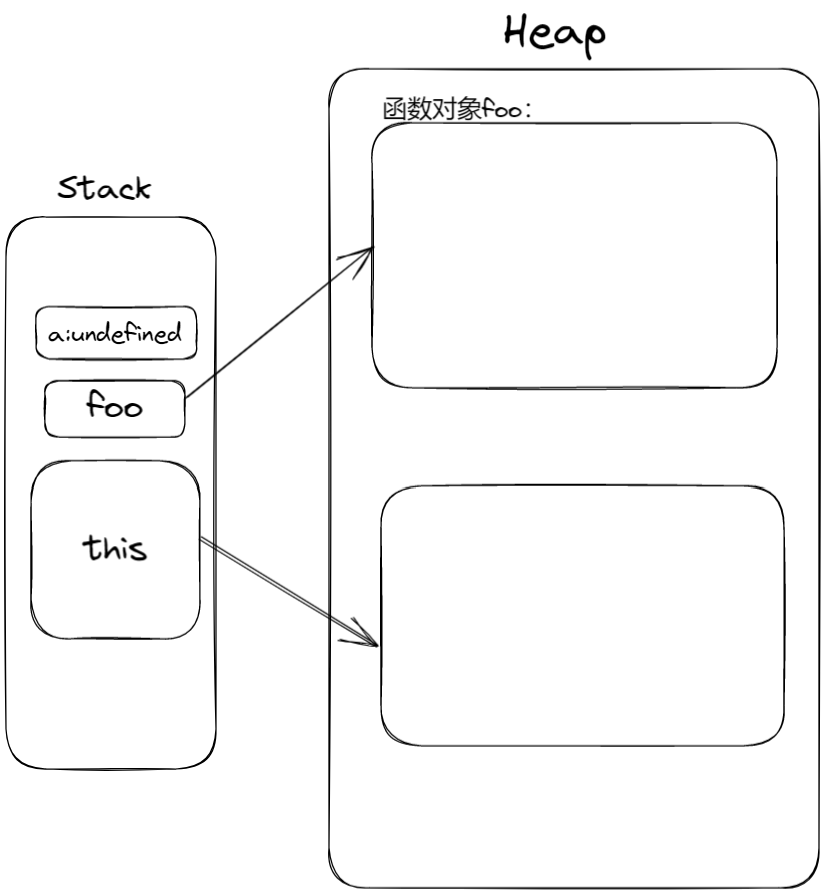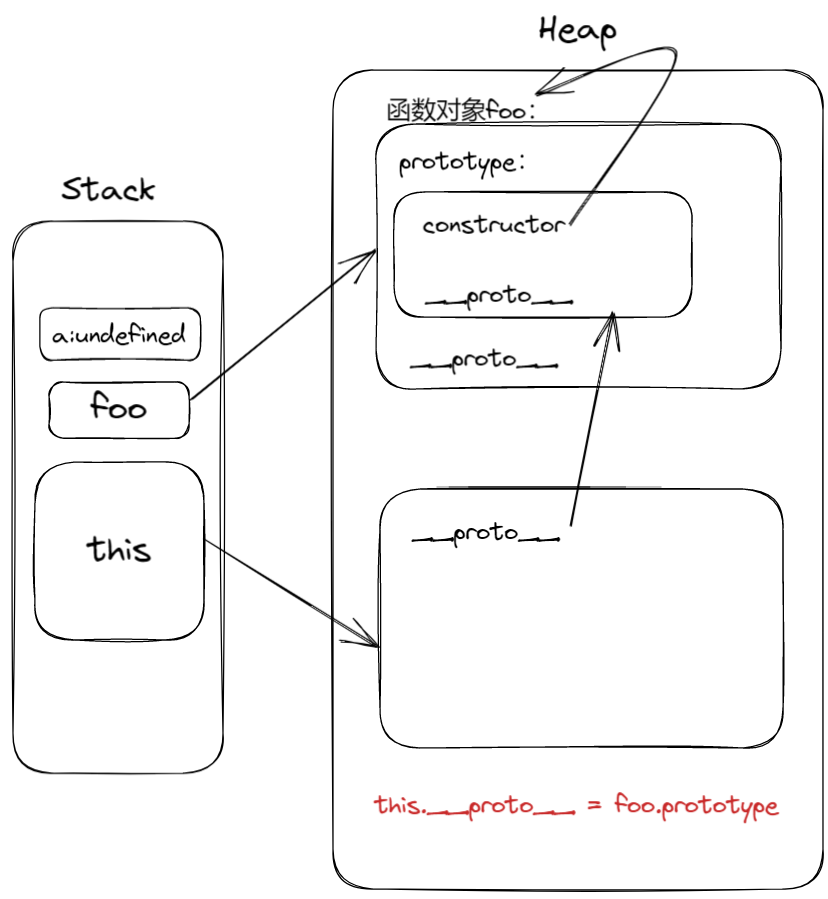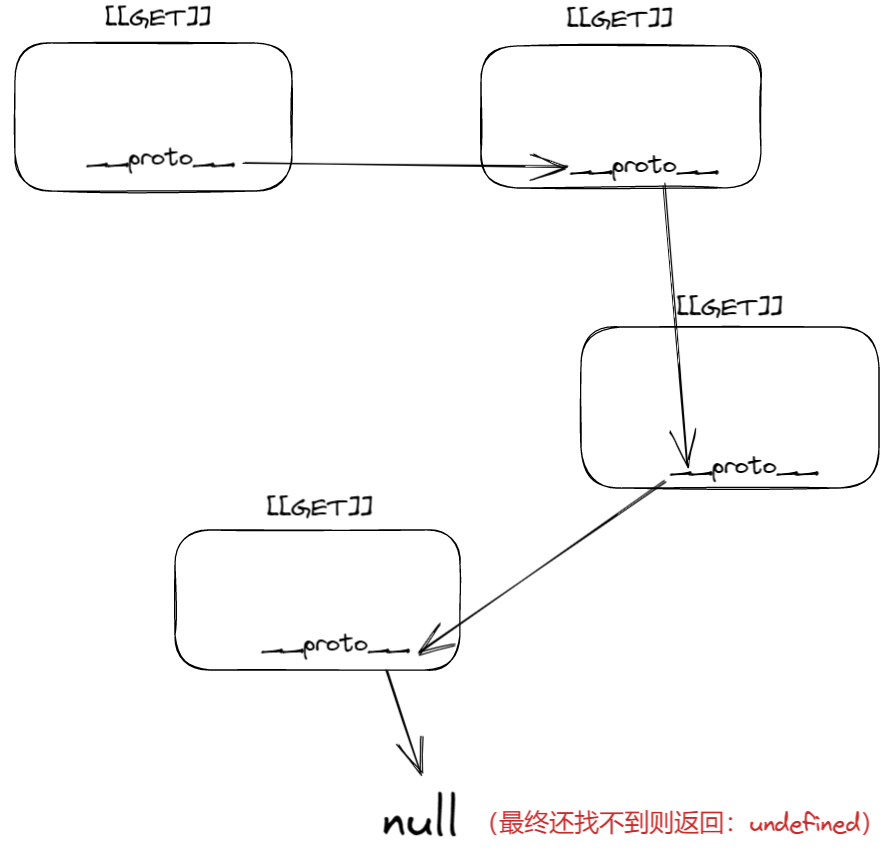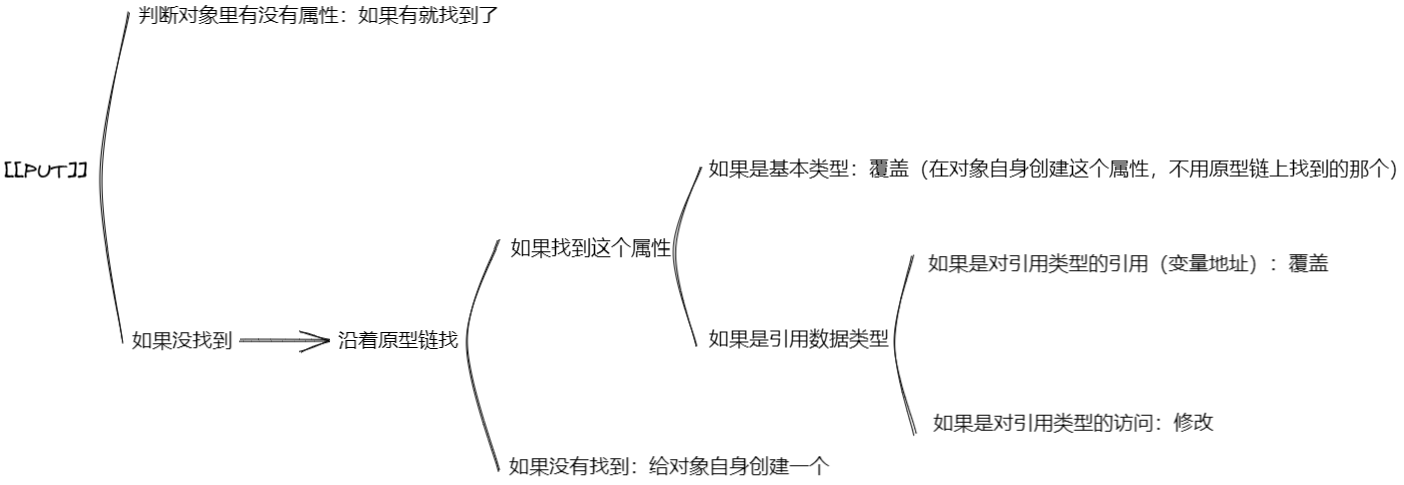原型与原型链
放点东西占位
由来
JS 中是没有 类(class)的,但是又想用 JS 进行面向对象编程,所以,引入了 原型链,利用 原型链 来 模拟类,实现面向对象编程。
理解原型链的关键
理解原型链的关键
- 理解
new关键字的作用机制(写) - 理解
[[GET]]函数的机制(读)
前置知识
- JS中所有对象都有
[[Prototype]](__proto__)隐式属性,如果是函数对象,则还有一个prototype显示属性。隐式属性就是程序不能直接访问的属性,因此JS提供了__proto__这个属性来让我门使用[[Prototype]],这俩是一个东西,就是名字不同。 - 构造函数
function foo() {
console.log(1)
}
const a = new foo() // 当一个普通函数左侧加了 new 关键字,它就变成了一个 构造函数function foo() {
console.log(1)
}
const a = new foo() // 当一个普通函数左侧加了 new 关键字,它就变成了一个 构造函数new 关键字的执行流程
以上面的构造函数foo()为例
- 绑定
this为空对象

- 给空对象添加
[[Prototype]](__proto__)隐式属性,并指向new后面函数(也就是foo())的prototype属性。(这一步其实就是:this.__proto__ = foo.prototype)
注:这就是为什么所有对象都有[[Prototype]](__proto__)这个属性,因为所有对象本质上都是new出来的,new的过程中就会给对象添加[[Prototype]]隐式属性。

- 正常执行函数
- 如果函数返回的是基本类型,则返回
this的值,否则返回原函数的返回值。
注:当前函数foo没有返回值,默认返回undefined,而undefined是基本类型,所以返回this
[[GET]] 执行流程
function foo() {
console.log(1);
}
let a = new foo();
a.b; //由上可知,a 指向 foo.prototype,其中并没有 属性 b,返回 undefinedfunction foo() {
console.log(1);
}
let a = new foo();
a.b; //由上可知,a 指向 foo.prototype,其中并没有 属性 b,返回 undefined思考一下,为什么
a.b会返回undefined?a.b访问对象属性的本质,其实是底层帮你调用了一个[[GET]]函数
- 判断对象
a中有没有属性 - 如果没有,沿着原型链
a.__proto__一直递归查找(注意,这时又触发了[[GET]]),如果最后没找到,返回undefined

原型链的应用
instanceof
作用:判断 xxx 是不是 xxx 的一个实例
function Student(name, age, gender) {
this.name = name;
this.age = age;
this.gender = gender;
}
var s1 = new Student('小明', 18, '男');
s1 instanceof Student; // true
s1 instanceof Object; // truefunction Student(name, age, gender) {
this.name = name;
this.age = age;
this.gender = gender;
}
var s1 = new Student('小明', 18, '男');
s1 instanceof Student; // true
s1 instanceof Object; // true底层逻辑:
- 判断
s1.__proto__ === Student.prototype(true),s1.__proto__ === Object.prototype(false) - 如果为false则递归查询:
s1.__proto__ = Student.prototype==>Student.prototype.__proto__ = Object.prototype(true)
根据上述逻辑封装一个myInstanceof方法:
// 参数:obj 为 instance 左边对象,Fun 为 instance 右边函数
Object.myInstanceof() = function (obj, Fun) {
if (obj === null) return false
if(obj.__proto__ === Fun.prototype) {
return true
} else {
return Object.myInstanceof(obj.__proto__, Fun)
}
}
// 因为使用 obj.__proto__属性效率很低,所以我们使用es新的Object.getPrototypeOf(obj)来获取到一个对象的原型链所指向的原型对象
Object.myInstanceof() = function (obj, Fun) {
if (obj === null) return false
if(Object.getPrototypeOf(obj) === Fun.prototype) {
return true
} else {
return Object.myInstanceof(Object.getPrototypeOf(obj), Fun)
}
}// 参数:obj 为 instance 左边对象,Fun 为 instance 右边函数
Object.myInstanceof() = function (obj, Fun) {
if (obj === null) return false
if(obj.__proto__ === Fun.prototype) {
return true
} else {
return Object.myInstanceof(obj.__proto__, Fun)
}
}
// 因为使用 obj.__proto__属性效率很低,所以我们使用es新的Object.getPrototypeOf(obj)来获取到一个对象的原型链所指向的原型对象
Object.myInstanceof() = function (obj, Fun) {
if (obj === null) return false
if(Object.getPrototypeOf(obj) === Fun.prototype) {
return true
} else {
return Object.myInstanceof(Object.getPrototypeOf(obj), Fun)
}
}数组和类数组
数组、类数组的本质都是对象
// 字面量方式创建数组
let arr = [1, 2, 3]
// 等价于下面的对象
arr = {
'0': 1,
'1': 2,
'2': 3,
length: 3,
[[Prototype]]: Array.prototype //或__proto__: Array.prototype
}
// 类数组
arr_like = {
'0': 1,
'1': 2,
'2': 3,
length: 3
[[Prototype]]: xxxxx // 原型链不知道指向谁,反正不是 Array.prototype
}// 字面量方式创建数组
let arr = [1, 2, 3]
// 等价于下面的对象
arr = {
'0': 1,
'1': 2,
'2': 3,
length: 3,
[[Prototype]]: Array.prototype //或__proto__: Array.prototype
}
// 类数组
arr_like = {
'0': 1,
'1': 2,
'2': 3,
length: 3
[[Prototype]]: xxxxx // 原型链不知道指向谁,反正不是 Array.prototype
}由上可知,数组和类数组的区别主要是原型链的指向不同,数组一定指向Array.prototype,但是类数组不指向
这样会造成一个问题:类数组访问不到Array.prototype中的方法。为了解决这个问题我们需要把类数组转换成数组。
隐式原型的修改
- 浏览器提供:
__proto__ - ECMA:
Object.getPrototypeOf(obj)等价于obj__proto__但效率更高 - ECMA:
Object.setPrototypeOf(obj, obj)这个一般不要用,原因如下(引用自MDN)
⚠️警告
由于现代 JavaScript 引擎优化属性访问所带来的特性的关系,更改对象的 [[Prototype]] 在各个浏览器和 JavaScript 引擎上都是一个很慢的操作。此外,修改继承的影响是微妙和广泛的,并不仅限于在 Object.setPrototypeOf(...) 语句上的时间花费,而是可能扩展到任何访问已更改 [[Prototype]] 属性的对象的代码。你可以在 JavaScript 引擎基础知识:优化原型中了解更多信息。
由于这个特性是语言的一部分,因此引擎开发人员实现该特性的性能(理想情况下)仍然是一个负担。在引擎开发人员解决这个问题之前,如果你担心性能问题,应该避免设置对象的 [[Prototype]] 属性。而是使用 Object.create() 创建一个具有所需 [[Prototype]] 属性的新对象。
Object.create(obj)返回一个以 obj 为原型的新对象,等价于:
let newObj = {}
Object.getPrototype(newObj) = obj
// 注:如果 obj 为 function,则
Object.getPrototype(newObj) = obj.prototype // Object.create(obj.prototype)let newObj = {}
Object.getPrototype(newObj) = obj
// 注:如果 obj 为 function,则
Object.getPrototype(newObj) = obj.prototype // Object.create(obj.prototype)LHS、RHS(状态的读写)[[GET]]、[[PUT]]
let b = 2; // 将 2 写入 b,LHS左查询 用 [[PUT]]
let a = b; // 先读 b,用 RHS右查询 用 [[GET]],再写入 a,LHS左查询 用 [[PUT]]let b = 2; // 将 2 写入 b,LHS左查询 用 [[PUT]]
let a = b; // 先读 b,用 RHS右查询 用 [[GET]],再写入 a,LHS左查询 用 [[PUT]]上面已经有[[GET]]的执行流程,这里不再赘述。
[[PUT]] LHS 的执行流程用一张图概括:

简单总结一句话:如果是 基本类型、引用类型的引用、原型链最终没有找到这三种情况,则都是在自身对象创建一个同名属性覆盖掉。如果是访问引用数据类型内的数据,则修改访问数据
相关面试题
1. 阿里四面真题
//实例方法
Object.prototype.a = function () {
console.log('a');
};
//实例方法
Function.prototype.b = function () {
console.log('b');
};
var F = function () {}; //函数对象 new Function
var f = new F();
//问:以下打印啥
f.a();
// a [[GET]]:
// f.__proto__ --> F.prototype 没有
// F.prototype.__proto__ --> Object.prototype.a = function() { console.log('a') } 找到了 输出 a
f.b();//undefined 现在是找不到这个属性 控制台就直接报错
// b [[GET]]:
// f.__proto__ --> F.prototype 没有
// F.prototype.__proto__ --> Object.prototype 没有
// Object.prototype.__proto__ --> null 没有,找不到就返回 undefined
F.a();//a
// F.__proto__ --> Function.prototype 没有
// Function.prototype.__proto__ --> Object.prototype 有,输出 a
F.b();//b
// F.__proto__ --> Function.prototype 有,输出 b//实例方法
Object.prototype.a = function () {
console.log('a');
};
//实例方法
Function.prototype.b = function () {
console.log('b');
};
var F = function () {}; //函数对象 new Function
var f = new F();
//问:以下打印啥
f.a();
// a [[GET]]:
// f.__proto__ --> F.prototype 没有
// F.prototype.__proto__ --> Object.prototype.a = function() { console.log('a') } 找到了 输出 a
f.b();//undefined 现在是找不到这个属性 控制台就直接报错
// b [[GET]]:
// f.__proto__ --> F.prototype 没有
// F.prototype.__proto__ --> Object.prototype 没有
// Object.prototype.__proto__ --> null 没有,找不到就返回 undefined
F.a();//a
// F.__proto__ --> Function.prototype 没有
// Function.prototype.__proto__ --> Object.prototype 有,输出 a
F.b();//b
// F.__proto__ --> Function.prototype 有,输出 b2. 输出什么?
function A() {}
A.prototype.n = 3;
A.prototype.add = function () {
this.n++; //重点是这里要 拆解成:this.n = this.n + 1; 因此要先用 RHS[[GET]] 获取到 this.n 的值+1,然后在 LHS[[PUT]] 修改 this.n
}
var a = new A();
var b = new A();
var c = new A();
a.add();
b.add();
console.log(a.n,b.n,c.n);function A() {}
A.prototype.n = 3;
A.prototype.add = function () {
this.n++; //重点是这里要 拆解成:this.n = this.n + 1; 因此要先用 RHS[[GET]] 获取到 this.n 的值+1,然后在 LHS[[PUT]] 修改 this.n
}
var a = new A();
var b = new A();
var c = new A();
a.add();
b.add();
console.log(a.n,b.n,c.n);点击查看答案
4, 4, 34, 4, 33. 输出什么?
function A() {}
A.prototype.m = { t: 1 };
A.prototype.add = function() {
this.m = {};
}
var a = new A();
a.add();
console.log(a.m.t);function A() {}
A.prototype.m = { t: 1 };
A.prototype.add = function() {
this.m = {};
}
var a = new A();
a.add();
console.log(a.m.t);点击查看答案
undefinedundefined4. 比较相等吗?
function Person(name, age) {
this.name = name;
this.age = age;
this.eat = function() {
console.log(age + '岁的' + name + '在吃饭。');
}
}
Person.run = function() {} //静态方法
Person.prototype.walk = function() {}
let p1 = new Person('xiaoming', 18);
let p2 = new Person('xiaoming', 18);
console.log(p1.eat === p2.eat);
console.log(p1.run === p2.run);
console.log(p1.walk === p2.walk);function Person(name, age) {
this.name = name;
this.age = age;
this.eat = function() {
console.log(age + '岁的' + name + '在吃饭。');
}
}
Person.run = function() {} //静态方法
Person.prototype.walk = function() {}
let p1 = new Person('xiaoming', 18);
let p2 = new Person('xiaoming', 18);
console.log(p1.eat === p2.eat);
console.log(p1.run === p2.run);
console.log(p1.walk === p2.walk);点击查看答案
false
true
truefalse
true
true5. foo1能访问到哪些属性?
function foo() {
this.some = '222'
let ccc = 'ccc'
foo.obkorol = 'obkorol'
foo.prototype.a = 'aaa'
}
foo.koro = '扣肉';
foo.prototype.test = 'test';
let foo1 = new foo();
foo.prototype.test = 'test2';
//问:foo1 访问到哪些属性?function foo() {
this.some = '222'
let ccc = 'ccc'
foo.obkorol = 'obkorol'
foo.prototype.a = 'aaa'
}
foo.koro = '扣肉';
foo.prototype.test = 'test';
let foo1 = new foo();
foo.prototype.test = 'test2';
//问:foo1 访问到哪些属性?点击查看答案
// 能访问到以下3个属性:
some: '222', a: 'aaa', test: 'test2'// 能访问到以下3个属性:
some: '222', a: 'aaa', test: 'test2' GravityDocs
GravityDocs